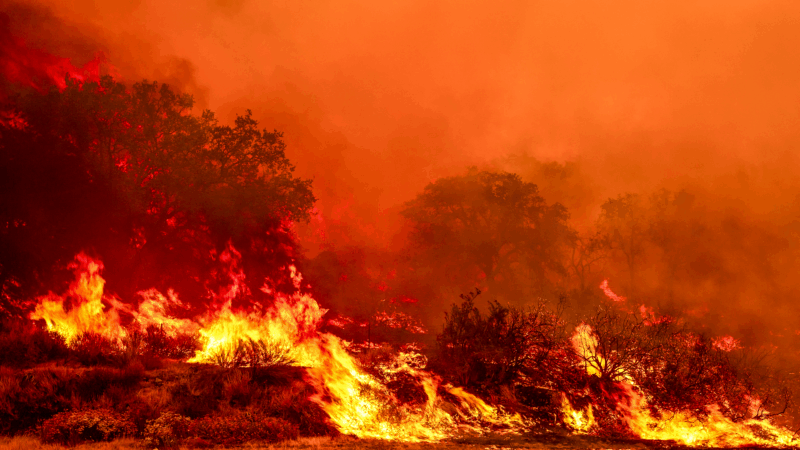The Trump administration wants to build more roads through national forests
The Trump administration wants to build more roads in the country’s national forests by rescinding a decades-old rule that protects nearly 60 million acres of forested lands.
On Friday, the U.S. Department of Agriculture is expected to formally start the process of undoing the 2001 Roadless Rule — a move that it argues will help the country’s firefighters.
“For nearly 25 years, the Roadless Rule has frustrated land managers and served as a barrier to action — prohibiting road construction, which has limited wildfire suppression and active forest management,” U.S. Forest Service Chief Tom Schultz said in a press statement Wednesday.
Forest ecologists and fire scientists say it’s not that simple, and they warn that more roads could lead to more wildfires.
“The law of unintended consequences is a very real law,” said Alexandra Syphard, senior research scientist with the Conservation Biology Institute and the director of science for the Global Wildfire Collective, which aims to connect fire scientists with wildfire managers.
Syphard, a research ecologist who has been studying wildfire for almost 30 years, said that historically, when it comes to roads and wildfires, a clear pattern has held.
“One of the most fundamental concepts in fire, especially in terms of fire geography, is that roads are the dominant place where you see ignitions,” Syphard said.
The reason is twofold. Where there are roads, there are people. And where there are people, there tend to be wildfires. Additionally, plowing roads into roadless forests and cutting through forest canopies can change the types of vegetation that grow on the forest floor.
A study by the Forest Service’s Rocky Mountain Research Station, published in 2020, found that non-native plants are twice as common within 500 feet of a road as they are farther away. The study, which aimed to address the broader assertion that roads are needed to prevent fires, concluded: “Speculation that eliminating road prohibitions would improve forest health is not supported by nearly twenty years of monitoring.”
The USDA, which includes the Forest Service, did not respond to a request for comment.
Managing forests to reduce wildfire
The Roadless Rule has been a source of conflict and litigation between states, industry and environmental groups since its creation in 2001.
During his first term, President Trump stripped roadless protections for Alaska’s Tongass National Forest — the largest intact temperate rainforest in the world — only for them to be restored by the Biden administration in 2023.
Environmental organizations argue that the Trump administration’s most recent efforts to rescind roadless protections are driven more by a desire to increase timber production in national forests than by a need to reduce wildfire risk. President Trump signed an executive order in March calling for a 25% increase in the nation’s timber production.

Outside of Alaska, rescinding roadless protections won’t open up a bunch of stands of harvestable timber, said former Forest Service Chief Dale Bosworth, who served under President George W. Bush right after the Roadless Rule was first implemented.
“The areas that were left roadless, were left roadless for a reason,” he said. “Because they didn’t have the timber in there and because it was expensive to do road construction.”
Bosworth said if the Trump administration wants to reduce wildfire risk in roadless areas, there’s an opportunity to do it under the existing rule. While the Roadless Rule prohibits large-scale logging, it does have an exception for smaller-diameter timber to be cut and sold if it improves habitat for threatened or endangered species, or it reduces the risk of “uncharacteristic wildfire” — that is, more severe wildfires than the area would normally have.
“In my view, our timber program should be focused on [improving forest health] anyway, whether you’re going into a roadless area or whether you’re doing that in other areas,” he said. “If we really focused on that, we’d be probably providing more timber on accident than we do on purpose.”
A notice of intent to roll back the Roadless Rule, published Thursday by the Trump administration, noted that while exceptions to the rule are sometimes made, “the use of exceptions has been limited, and the majority have been for forest stewardship purposes.”
“Surgical” use of roads may be helpful
There are situations where roads are beneficial to wildfire suppression efforts.
A 2021 study by researchers in Oregon found that while roadless areas in Western forests had fewer ignitions than places with roads, the fires that did start tended to burn more land.
“Fires that start near roads tend to be controlled more quickly and smaller for obvious reasons of rapid detection and access [for firefighters],” said Matt Thompson, a former research forester at the Forest Service and the vice president of wildfire risk analytics at Vibrant Planet, who was not involved in the 2021 study.
Being able to quickly detect and suppress fires near homes or other valuable resources is a good thing, he said, but when fires are burning in roadless areas they’re often far away from both.
Roads can also be a fuel-break for firefighters — a vegetation-less barrier that they can use to try to stop or slow a fire’s growth.
In its initial announcement that it would be rescinding the Roadless Rule, the Trump administration said it had identified 28 million acres of roadless areas that are at high or very high risk of wildfire. Thompson said he’s curious where those acres are — and the USDA didn’t respond to NPR’s questions about that finding.
But he said if the administration took “a surgical approach” to building roads in areas where they could be used as fire breaks to protect communities or homes, and provide for firefighter safety, it could be beneficial.
“The question is, will we have the resources and can we get that done in time so it’s not just a new risk sitting out there?” Thompson said.
The public comment period on the proposed rescission ends Sept. 19.
Auburn fires coach Hugh Freeze following 12th loss in his last 15 SEC games
The 56-year-old Freeze failed to fix Auburn’s offensive issues in three years on the Plains, scoring 24 or fewer points in 17 of his 22 league games. He also ended up on the wrong end of too many close matchups, including twice this season thanks partly to questionable calls.
In a ‘disheartening’ era, the nation’s former top mining regulator speaks out
Joe Pizarchik, who led the federal Office of Surface Mining Reclamation and Enforcement from 2009 to 2017, says Alabama’s move in the wake of a fatal 2024 home explosion increases risks to residents living atop “gassy” coal mines.
‘It’s like feeling the arms of your creator just wrapped around you’: a visit to a special healing Shabbat
Members of Temple Emanu-El in Birmingham gathered recently for their traditional Friday Shabbat service. But this particular service was different, as could be seen by all the people dressed in their finest pink.
Space Command is coming to Huntsville. What might that mean for first-time homebuyers
While Huntsville has been a more affordable market than other growing cities, what’s it been like for those looking for their first home?
Colorado says relocation of Space Command to Alabama is ‘punishment’ for mail-in voting
The litigation announced by Colorado Attorney General Phil Weiser asks a federal judge to block the move as unconstitutional.
Breaking down Alabama’s CHOOSE Act
It’s been a year since Alabama legislators passed the CHOOSE Act allowing families to apply for state funds to use towards homeschool expenses and tuition for participating private schools. The Alabama Daily News’ education reporter Trisha Powell Crain has been diving into how the funds are being used. WBHM’s Andrew Gelderman sat down with her to talk about what we’re seeing so far.









